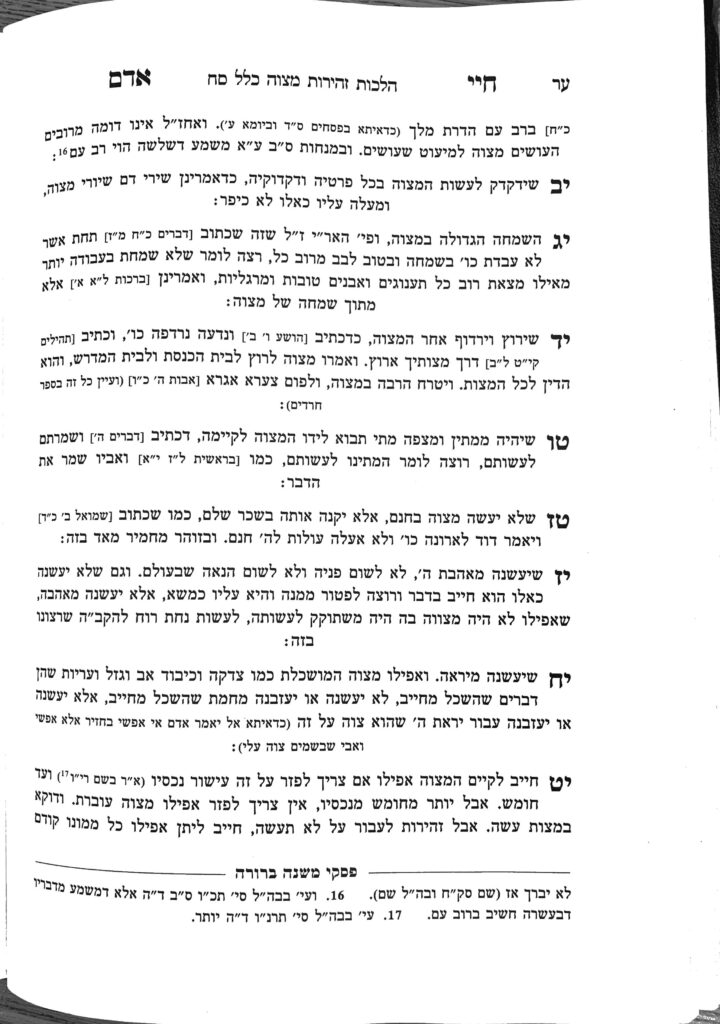We are beginning siman 12. The Chayei Adam writes that a person should be careful to perform a mitzvah with all of its details. The Chayei Adam quotes the Gemara which discusses the different places in which the blood of a korban must be placed on the mizbeach. For example, the blood of a chatas is placed in all four corners, and the blood of an olah is placed in two opposite corners. The leftover blood is poured out over the yesod of the mizbeach. Bedieved, if the blood is not poured over the yesod, the korban is kosher, but there is a halacha that the kohen should preferably do so. Similarly, semicha (placing both hands on the korban, leaning down, and reciting vidui) is not meakeiv. The Gemara refers to semicha as the shiyarei mitzvah, the extra parts of the mitzvah. However, the Gemara says that if one does not do semicha, it is as though one did not attain a full kaparah.
The Gemara records a machlokes regarding what it means that one did not attain a full kaparah. Rava understands that the korban is kosher, and the person missed the additional mitzvah of semicha. Rav Huna disagrees, and understands that although the korban is effective, Hashem does not receive a nachas ruach from the mitzvah, because he did not perform the mitzvah properly. Although the mitzvah has been performed, the mitzvah is missing one of its intrinsic components. So, albeit that one fulfills the mitzvah, as far as Hashem is concerned, by the person lacking the interest and desire to do it properly, it’s akin to not performing the mitzvah at all.
The Gemara also uses the term shiyarei mitzvah in regards to the na’a’nuim of the lulav, and Rava and Rav Huna would likely have the same machlokes there as well.
The language of the Chayei Adam would seem to indicate he is following the opinion of Rav Huna, which is the opinion of the Rambam as well.
This concept is similar to hiddur mitzvah, but it is more intrinsic to the mitzvah. In other words, even though beideved the mitzvah is fulfilled, and the shiyarei mitzvah are not meakeiv, the mitzvah itself is missing some of its form.
There are two halachic implications to the diference between hiddur mitzvah and shiyarei mitzvah. It is quoted from Rav Shteinman ztl that in a situation in which one cannot perform the mitzvah with the shiyurei mitzvah now, but will be able to perform it with its shiyarim later, he suggests that one should wait until later to perfom the mitzvah with its shiyarim. This question is not the same as the question about whether hiddur mitzvah or zrizin makdimin takes precedence, because shiyarei mitzvah is more intrinsic. In the Sefer Shomrei Mitzvah, the author suggests that maybe a person should repeat the mitzvah later when they will be able to perform it with its shiyarim. He points out that it could be that the Chayei Adam is simply teaching us in this siman that one should perform a mitzvah properly, or, given the proofs he brings from the Gemara, he could be making the point that even if the mitzvah is valid, the mitzvah has not been done properly, and he suggests that one should repeat the mitzvah
Summary
A person should be careful to perform a mitzvah with all of its details, known as shiyarei mitzvah. If a person does not, they have still fulfilled the mitzvah, but their mitzvah will be missing certain important intrinsic components.



